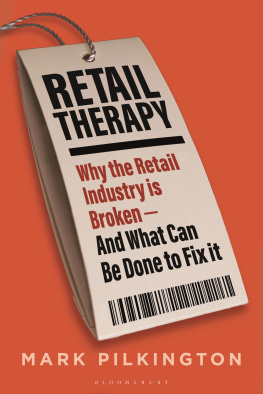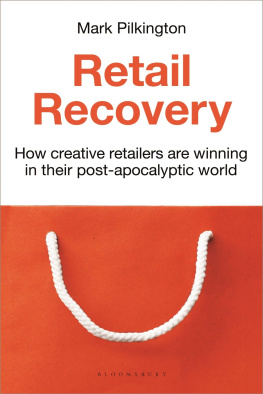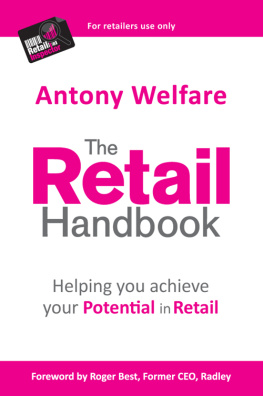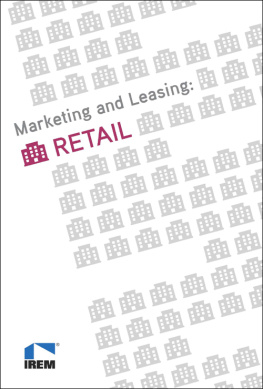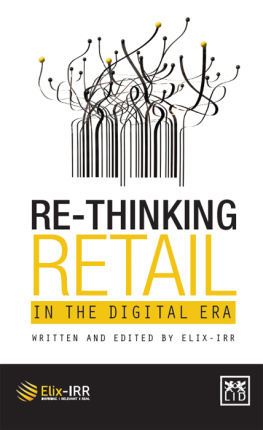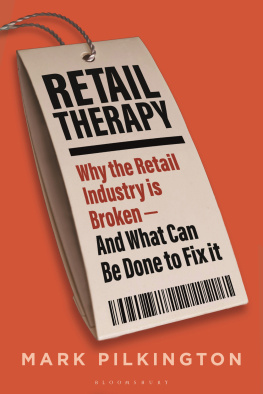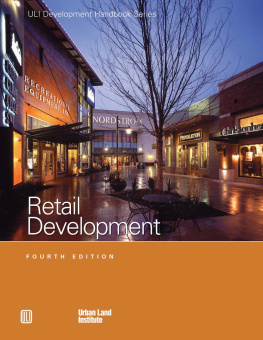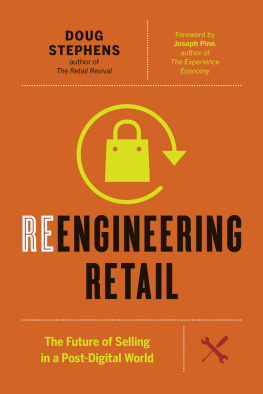RETAIL THERAPY
RETAIL THERAPY
Why the retail industry is broken and what can be done to fix it
MARK PILKINGTON

Contents
The world of retailing, as we know it, is going under.
Unlike a stock market crash, this isnt a sudden crisis mainly because that is not the way retailing works. But day after day the news just keeps getting worse and worse.
Since 2015, weve seen the escalation of the most severe crisis ever to hit the global retailing industry. In the UK, many retailers have gone under, and hundreds more are struggling. Among the insolvencies are high-profile casualties such as House of Fraser, Mothercare, ToysRUs, BHS, Carpetright, Maplin, Jacques Vert, East, Jaeger, Austin Reed and HMV.
Over 8,000 major brand chain stores closed their doors in 2017 in the United States alone.
The problem is affecting all sectors, from fashion to banking, and at all price levels, from luxury through to discount. A number of premium brands and luxury houses have seen periods of flat or declining sales, particularly in the Overall, about 90 per cent of US retailers have experienced sales declines.
But nothing is as frightening as what is happening to the department stores. Companies like Debenhams and House of Fraser in the UK, and Sears, JC Penney and Macys in the United States, have seen their businesses badly affected in the last few years. They are closing thousands of stores between them, and there is a real question mark as to whether the organizations themselves will survive.
It is not just the retailers who are suffering. As their businesses decline, the brand suppliers who depend on them are also experiencing significant problems. Highly successful companies like Procter & Gamble, Under Armour and Mattel have seen declining sales as their retail customers cut back, especially in the US markets.
Where did it all go wrong?
All round the world, there are signs of a retail sector in crisis, and the problem is not limited to the UK and the United States. Retailers are struggling and going bankrupt across Europe, Russia, South America, the Middle East and the Far East.
And unlike in 2008, it is not the economy that is causing the problem. It is true that 2008 was a very difficult time for retailers, but it was also understandable it was in the middle of the worst economic downturn since the Second World War. The current storm, on the other hand, has blown up out of the clear skies of a growth economy that has been enhanced by low unemployment and booming stock markets.
What on earth is going on? Well, it appears that the slow death of retail, which has been predicted and discussed for so long, is finally happening.
People often say, But is this really new? After all, retail seems to have been struggling for a long time. Well, yes, individual retailers have struggled; but this is different this has the potential to affect almost everyone.
Because retailing is a high fixed-cost business, with heavy investments in store construction, long rental leases and significant stocks of goods, it only takes a few years of sales decline before the whole thing tips over like the Titanic filling with water.
Why retail is so important?
Why should you care? Well, you may be a shopper, concerned about the disappearance of your favourite brands from your local shopping district or mall. You may be someone who works in retailing, or in one of the suppliers who depend on the retail sector. Or you may be an investor, worried about what all this means for the future of the economy.
Employment
Whoever you are, the truth is that retailing affects all of us. Shops, and the suppliers that they support, are one of the biggest parts of the global economy. Retailing globally had sales of US$23 trillion in 2015, and represents 31 per cent of global GDP, employing literally billions of people.
In the United States it employs fifteen million people directly and another fifteen million jobs depend on it, including suppliers. And the retail decline is only just beginning to gather speed. In the next few years, that momentum will increase and it will begin to threaten the whole economy.
If you look at the types of jobs that retail provides, these are often a godsend for the more vulnerable groups in society. It is almost the only type of job that does not require much in the way of qualifications, and those jobs are disproportionately weighted towards women, ethnic minorities and school leavers. These jobs provide work and incomes to people in every community, large and small, across the world. With manufacturing in decline, it has become almost the only type of job that is available in poorer areas, and those retail-related salaries are often the only things supporting fragile families.
Property and real estate
Retailing also plays a major part in the property market. Shops lease spaces in malls and on shopping streets, and the property itself is often owned by Real Estate Investment Trusts (REITs), which obtain their income from the rents paid by the retailers. As retailing declines, the malls and shopping streets are also being hit. All across the United States, for example, malls are starting to fall apart, especially in poorer communities. It is estimated that over 400 malls (out of a total of 1,200) will have to close in the next few years.
Even prime shopping areas like the so-called Golden Triangle in Manhattans Upper East Side, or selected streets in Londons West End, are A retail collapse threatens to deflate these assets in an extreme manner, and it is not too much to say that it could be a prime cause of the next global economic crisis.
What lies ahead?
What are governments doing about the crisis? Are they helping to support this industry which gives sustenance to so many communities across the world? Far from it in fact, in some ways, they seem bent on hastening its decline.
Whether it be the impact of Brexit, the national living wage, the high business rates and the apprenticeship levy in the UK, or the restrictions on immigration, the import tariffs and the fact that many internet companies have been permitted to avoid state sales tax in the United States, governments seem almost to be working against the retail industry, in complete ignorance of its vital role in society. In fact, retail gets very little attention, politically speaking: retail workers are not strongly unionized and they lack the photo-opportunity appeal of hard-hatted white male miners and steel workers.
So what can we do to stop the retail collapse, and the economic crisis that it is precipitating? Fortunately, solutions do exist. There are things that governments, brands and retailers can do to avoid the worst of the crisis. Unfortunately, there seems to be a lack of understanding of the underlying problems many retailers around the world are burying their heads in the sand, and national governments seem to be almost unaware of the problem at all.
The biggest issue is that even so-called retail industry experts are failing to really understand the problem. The causes of the retail apocalypse are multiple and complex. People blame it on e-commerce, and it is true that this is a key factor in the story. Yet there are many other causes, including the information revolution, generational changes, the role of private equity (PE) in increasing retail debt levels, and self-inflicted wounds from the retailers themselves.
Until all these causes are fully understood, there is little chance that either the retailers, the brands that supply them, or the governments who are charged with looking the health of our economies will be able to prevent the looming crisis that threatens us all.

